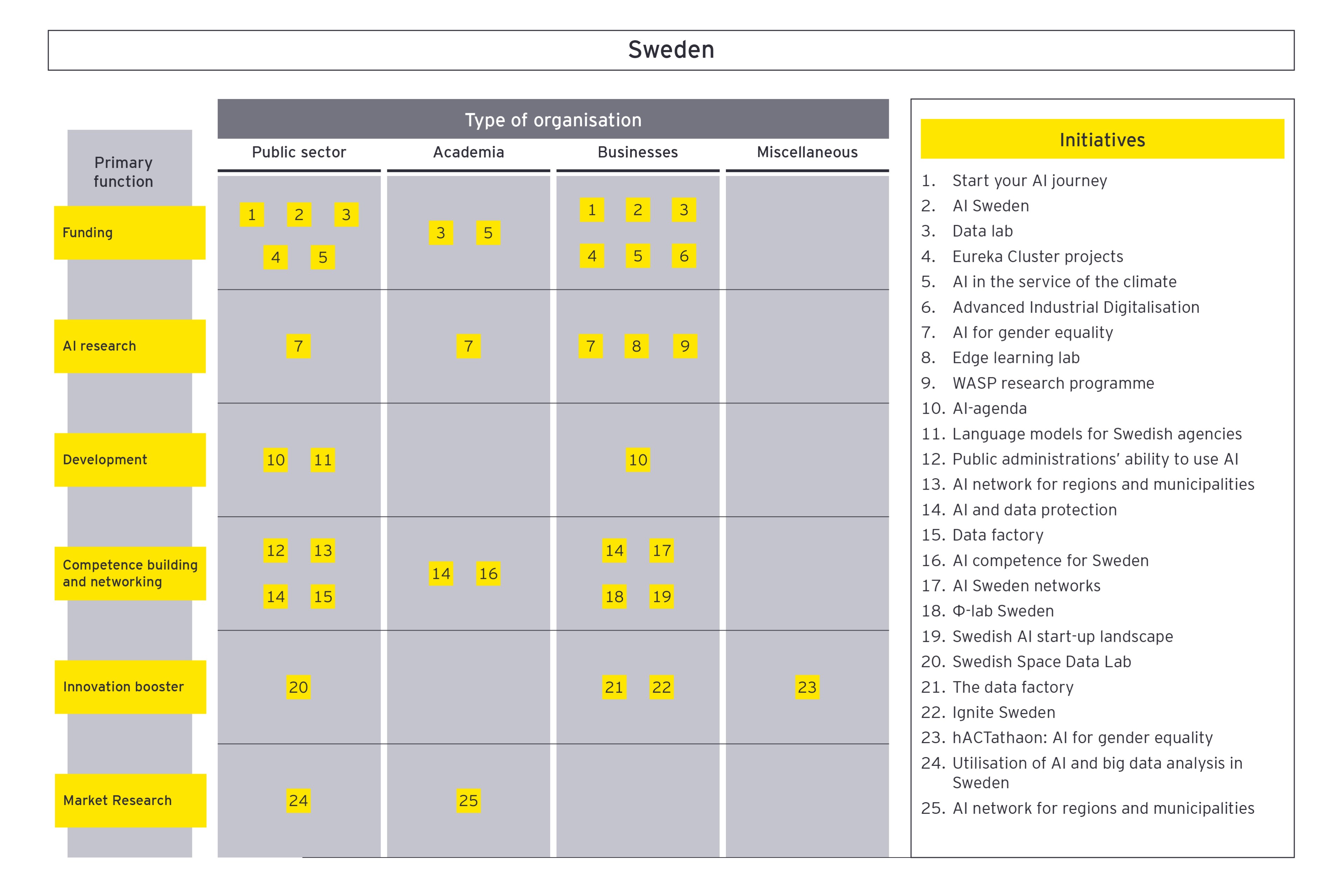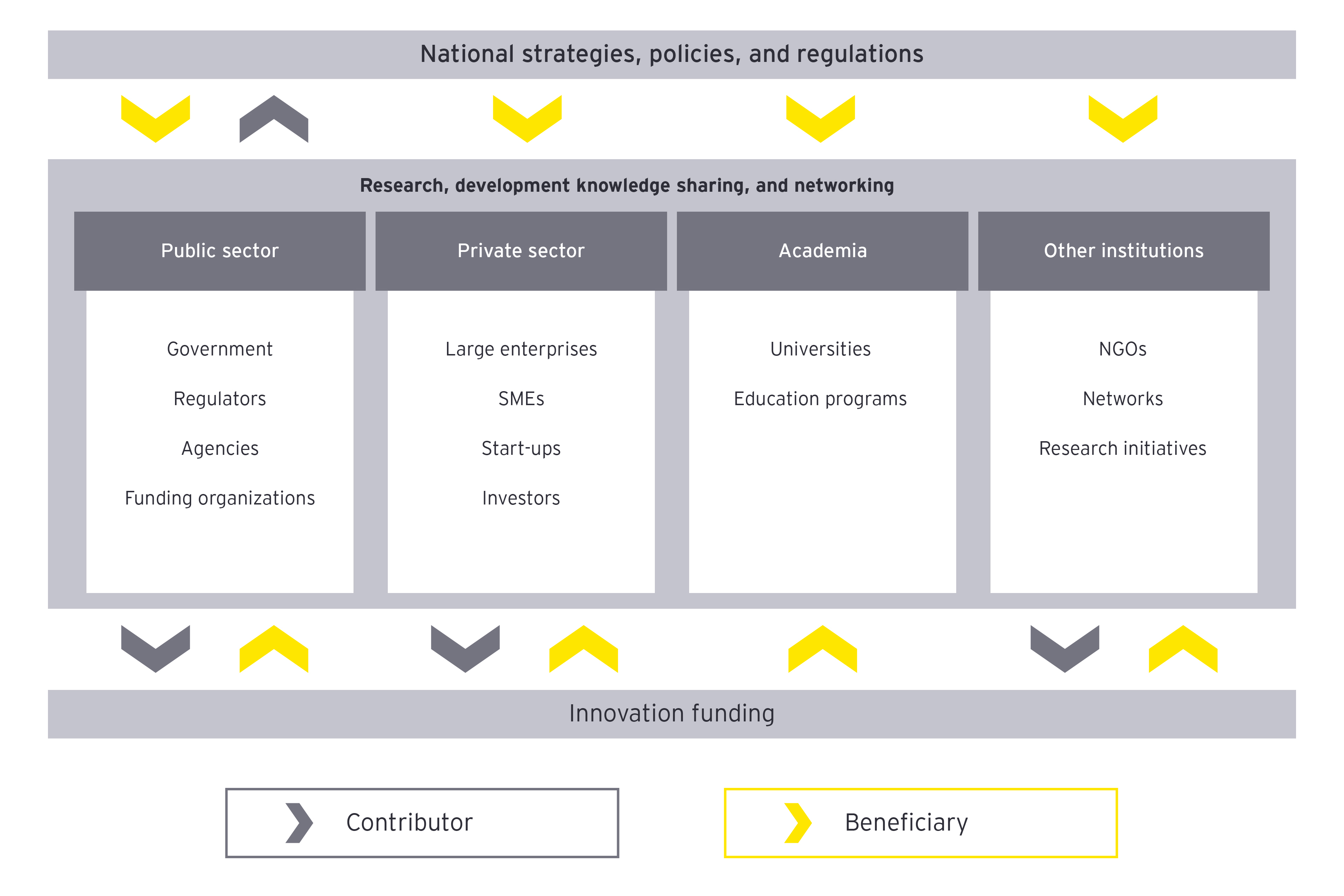
Chapter 1
National strongholds
Sweden has many ways in which it can support the Nordic region in pursuing AI development.
As a leading country in the Nordics on data and AI, there is one area—namely the private sector—where Sweden has been performing particularly well for many years.
Private sector innovation
Stockholm is a leader when it comes to start-up unicorns per capita. In addition to this already significant credential, Stockholm also creates the largest number of AI start-ups among the Nordic capitals according to Global AI Talent Report. These statistics paint a clear picture of Sweden’s thriving ecosystem for innovation in AI. Furthermore, the report also states that Sweden also has the largest talent pool for AI amongst the Nordic countries.
When viewed from the amount of funding that goes into innovation and start-ups, we find that Sweden invests at one of the highest rates in the world from the perspective of R&D as a percentage of GDP.
To make the most of these advantages, stakeholders from across the public and private sectors in Sweden need guidance on how to successfully leverage all the talent and funding that is available. Local experts point out that a prerequisite for more efficient innovation is clarity around how cooperation should function in practice.
By providing this support from a Nordic perspective, the whole region can experience a boost to AI development as the amplified scale from cross-border cooperation will make the impact of innovation even greater, and thereby spur additional funding in the coming years.

Chapter 2
National AI development challenges
Sweden currently faces one big challenge in AI development that requires immediate attention.
Out of all the challenges that Sweden shares with the other Nordic countries, there is one challenge where the country stands out compared to the rest of the Nordics.
A vague national strategy creates the need for additional guidance
One of the foundations for setting the course for a group of people or organizations is a clear strategy that is easy to understand and put into practice. This holds particularly true when each entity has a significant amount of freedom of choice regarding which path to take, which can lead to:
- Vastly differing approaches within the group to tackle a challenge
- A lack of action due to missing instructions
As mentioned earlier, the national AI strategy adopted by Sweden needs better clarity and direction for public and private organizations – especially against the backdrop of public organizations that have a relatively high degree of freedom in comparison to their Nordic counterparts.
While the Swedish AI strategy is too generic compared to what organizations and local experts would like to see, the overall agreement amongst stakeholders regarding the need for improvements showcases the potential for Nordic panning organizations to help guide the way. Stakeholders are hopeful to see a person or entity that can point to a joint scenario along with the path to get there.
By bringing this type of structure to Sweden, and indeed to the Nordics, the potential to succeed with the Nordic’s great ambitions in AI utilization becomes significantly more attainable.

Chapter 3
National actors
Many Swedish organizations have started to develop, test and pilot AI solutions.
In Sweden, many organizations have started the process of developing, testing and piloting AI solutions across the public and private sectors as well as within academia.
AI Sweden, Vinnova, the Agency for Digital Government (DIGG), the Research Institutes of Sweden (RISE), the Swedish Association of Local Authorities and Regions (SALAR) and Formas are among the key national actors that support AI on a broader scale.
Given below is a visual depiction of a small portion of the national AI and data ecosystem in Sweden.

A visualization of Sweden’s national AI and data ecosystem across organization types.
These national actors play a significant role in building a thriving AI ecosystem by providing funding, supporting AI research, development, competency building, networking, and market research, and acting as innovation boosters.

Chapter 4
National strategies and policies
The national data strategy can help Sweden lay the foundation for more concrete AI development.
The Swedish national strategy for AI was published in 2018 by the Ministry of Enterprise and Innovation to identify a way forward and set up guidelines for national priorities within the field of AI.
In 2021, the Ministry of Infrastructure published a strategy to make Sweden the leading country in data sharing, an area in which the Agency for Digital Government (DIGG) plays a significant role. At the core of the strategy are six focus areas that lay the foundation for long-term work that includes both the public and private sectors:
- Increased access to data
- Open and controlled data-sharing
- Cooperation and culture
- Control, regulation, and follow-up
- Research, development, and competency
- EU and international cooperation
Supported by these focus areas, the data strategy can augment Sweden’s data handling and lay the foundation for more concrete AI development. In addition, the data strategy is also closely aligned with the connected AI strategy, to strengthen Sweden’s welfare and competitiveness, and support a sustainable society.
Moving on to the topic of policies, DIGG has already been established as Sweden’s authority when it comes to digitalization. Tied to this, DIGG has published a list of six different policies surrounding data that are relevant to Sweden’s future AI development and that are to be followed by other public organizations within the country.

Chapter 5
National initiatives and programs
Sweden boasts many ambitious initiatives and programs related to fostering AI and data innovation.
The Swedish initiatives and programs cover many important topics related to pushing the national AI agenda, forward. Various types of funds and testbeds are available for those who need a boost to get started with AI, or who simply need access to more data and computational power than their organizations can muster.
There are research and collaboration initiatives between public and private organizations together with academia, as well as various initiatives that tackle ethical topics such as gender equality. Together, these initiatives and programs showcase the Swedish ecosystem as a well-rounded environment where most types of organizations of differing AI skill levels can find the tools and resources, they require to take their AI development to the next level.
Two initiatives can be considered as best practices in Sweden based on market research and expert interviews.
Best practice 1: Vinnova’s Start Your AI Journey
One of the key issues facing many public and private organizations is the inability to take the first crucial step into developing AI solutions. Vinnova used the “Start Your AI Journey” initiative to encourage AI innovation by providing several rounds of funding to public and private organizations that required a boost to get started. All in all, Start Your AI Journey is the type of innovation encouragement that could be leveraged for even greater value by introducing it within other Nordic countries.
Best practice 2: Networks for knowledge sharing and inspiration
Another best practice in Sweden is related to how organizations are building official and unofficial networks to learn more from each other and cooperatively progress faster with AI development. Seen from a Nordic perspective, these types of networking initiatives could create further value by bringing together more organizations, thereby raising the possibility for attendees to find similarities with each other and therefore find opportunities to cooperatively learn about AI development.
The bottom line
The strongholds and challenges explored in this article against the backdrop of national actors, strategies, policies, initiatives, and programs show that Sweden is on its way to becoming a leading hub for AI innovation. But to get there, Sweden needs to achieve measured progress in the four focus areas aggregated below:
- Increase the investments put into supporting collaboration with academia, to drive a higher pace of AI innovation.
- Secure better involvement from the leadership by helping them understand how to support AI development – ultimately helping AI projects move beyond the pilot stage.
- Ensure that investment capital for AI development is focused on a smaller number of large initiatives rather than spreading it too thin across a multitude of projects.
- Support organizations in the public sector from a national and Nordic perspective to get them working in the same direction, despite a vague national strategy.
Summary
Sweden has many strong characteristics when it comes to AI development. Sweden must seriously consider growth opportunities and focus on alleviating challenges that can hinder its AI innovation journey. Investments, better leadership and a strong national strategy are some immediate gaps to start with.


